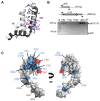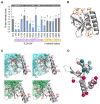The Signal Transduction Protein PII Controls the Levels of the Cyanobacterial Protein PipX
- PMID: 37894037
- PMCID: PMC10609283
- DOI: 10.3390/microorganisms11102379
The Signal Transduction Protein PII Controls the Levels of the Cyanobacterial Protein PipX
Abstract
Cyanobacteria, microorganisms performing oxygenic photosynthesis, must adapt their metabolic processes to environmental challenges such as day and night changes. PipX, a unique regulatory protein from cyanobacteria, provides a mechanistic link between the signalling protein PII, a widely conserved (in bacteria and plants) transducer of carbon/nitrogen/energy richness, and the transcriptional regulator NtcA, which controls a large regulon involved in nitrogen assimilation. PipX is also involved in translational regulation through interaction with the ribosome-assembly GTPase EngA. However, increases in the PipX/PII ratio are toxic, presumably due to the abnormally increased binding of PipX to other partner(s). Here, we present mutational and structural analyses of reported PipX-PII and PipX-NtcA complexes, leading to the identification of single amino acid changes that decrease or abolish PipX toxicity. Notably, 4 out of 11 mutations decreasing toxicity did not decrease PipX levels, suggesting that the targeted residues (F12, D23, L36, and R54) provide toxicity determinants. In addition, one of those four mutations (D23A) argued against the over-activation of NtcA as the cause of PipX toxicity. Most mutations at residues contacting PII decreased PipX levels, indicating that PipX stability would depend on its ability to bind to PII, a conclusion supported by the light-induced decrease of PipX levels in Synechococcus elongatus PCC7942 (hereafter S. elongatus).
Keywords: NtcA; PipX toxicity; Synechococcus elongatus; energy sensing; light and dark conditions; mutational analysis; nitrogen regulation network; protein interaction.
Conflict of interest statement
The authors declare no conflict of interest.
Figures




Similar articles
-
Analysing the Cyanobacterial PipX Interaction Network Using NanoBiT Complementation in Synechococcus elongatus PCC7942.Int J Mol Sci. 2024 Apr 25;25(9):4702. doi: 10.3390/ijms25094702. Int J Mol Sci. 2024. PMID: 38731921 Free PMC article.
-
Regulatory Connections Between the Cyanobacterial Factor PipX and the Ribosome Assembly GTPase EngA.Front Microbiol. 2021 Dec 9;12:781760. doi: 10.3389/fmicb.2021.781760. eCollection 2021. Front Microbiol. 2021. PMID: 34956147 Free PMC article.
-
Expanding the Cyanobacterial Nitrogen Regulatory Network: The GntR-Like Regulator PlmA Interacts with the PII-PipX Complex.Front Microbiol. 2016 Oct 28;7:1677. doi: 10.3389/fmicb.2016.01677. eCollection 2016. Front Microbiol. 2016. PMID: 27840625 Free PMC article.
-
The PII-NAGK-PipX-NtcA Regulatory Axis of Cyanobacteria: A Tale of Changing Partners, Allosteric Effectors and Non-covalent Interactions.Front Mol Biosci. 2018 Nov 13;5:91. doi: 10.3389/fmolb.2018.00091. eCollection 2018. Front Mol Biosci. 2018. PMID: 30483512 Free PMC article. Review.
-
Distinctive Features of PipX, a Unique Signaling Protein of Cyanobacteria.Life (Basel). 2020 May 28;10(6):79. doi: 10.3390/life10060079. Life (Basel). 2020. PMID: 32481703 Free PMC article. Review.
Cited by
-
Structures of the cyanobacterial nitrogen regulators NtcA and PipX complexed to DNA shed light on DNA binding by NtcA and implicate PipX in the recruitment of RNA polymerase.Nucleic Acids Res. 2025 Feb 8;53(4):gkaf096. doi: 10.1093/nar/gkaf096. Nucleic Acids Res. 2025. PMID: 39995039 Free PMC article.
-
Studies on the PII-PipX-NtcA Regulatory Axis of Cyanobacteria Provide Novel Insights into the Advantages and Limitations of Two-Hybrid Systems for Protein Interactions.Int J Mol Sci. 2024 May 16;25(10):5429. doi: 10.3390/ijms25105429. Int J Mol Sci. 2024. PMID: 38791467 Free PMC article.
-
Analysing the Cyanobacterial PipX Interaction Network Using NanoBiT Complementation in Synechococcus elongatus PCC7942.Int J Mol Sci. 2024 Apr 25;25(9):4702. doi: 10.3390/ijms25094702. Int J Mol Sci. 2024. PMID: 38731921 Free PMC article.
References
-
- Lee H.-W., Noh J.-H., Choi D.-H., Yun M., Bhavya P.S., Kang J.-J., Lee J.-H., Kim K.-W., Jang H.-K., Lee S.-H. Picocyanobacterial Contribution to the Total Primary Production in the Northwestern Pacific Ocean. Water. 2021;13:1610. doi: 10.3390/w13111610. - DOI
Grants and funding
LinkOut - more resources
Full Text Sources
Miscellaneous

